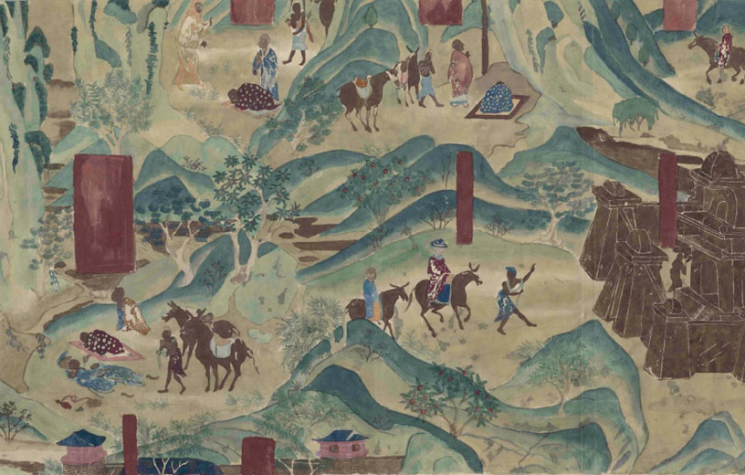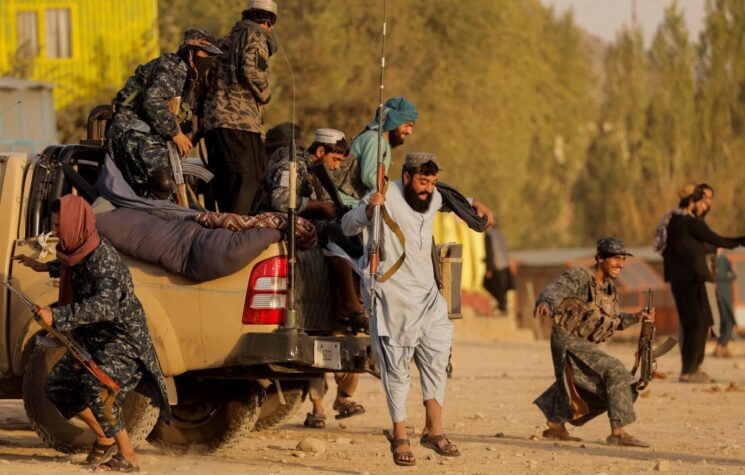With the transformation of the rules of the “Great Game” in the Middle East emerging out of President Trump’s recent Syrian surprise pullout and Putin’s brilliant manoeuvres since 2015, a sweeping set of development/reconstruction programs led by China now have a chance to become hegemonic across the formerly hopeless, terrorist-infested region.
The fact that the Arab states of the Middle East were targeted for destruction by western geopoliticians over the last 40 years is not un-connected to the region’s historic role as “cross-roads of civilizations” which were once the bridge between East and West along the ancient Silk Road (c. 250 BC). Today’s New Silk Road has brought 150 countries into a multipolar model of cooperation and civilization-building which necessitates a stabilized Middle East in order to function.
When asking “how could a reconstruction of the Middle East be possible after so many years of hell” I was pleasantly surprised to discover that both great projects once derailed have been given new life with the new prospects for peace and also new projects never before dreamed possible have been created as part of the New Silk Road (Aka: One Belt One Road).
Just to get a sense of this incredible potential that is keeping western oligarchs up at night, I want to quickly review just a few of the greatest China-led reconstruction projects which are now taking hold in four of the most decimated areas of the Middle East: Iraq, Syria, Yemen and Afghanistan.
Iraq Joins the New Silk Road
After decades of foreign manipulation, the Iraqi government was able to declare victory over Da’esh in 2017- just 3 years after the western-sponsored insurgents had gained control of one third of the territory. This new stability created by Russia’s intervention into Syria, unleashed a vast potential for China-led reconstruction to not only re-build the war-torn nation, but launch it into the 21st century.
In September 2019, Iraqi Prime Minister Adil Abdu-Mahdi announced Iraq’s participation in the New Silk Road standing alongside Xi Jinping in Beijing. Mahdi said: “Iraq has gone through war and civil strife and is grateful to China for its valuable support… Iraq is willing to work in the ‘One Belt One Road’ framework”. President Xi then said: “China would like, from a new starting point together with Iraq, to push for the China-Iraq Strategic Partnership”.
Part of this Strategic Partnership involves an Oil for Reconstruction program which will see Chinese firms exchange infrastructure-building for oil (100 000 barrels/day to be exact). Already Iraq is China’s 2nd largest supplier of overseas oil while China has become Iraq’s #1 trade partner. Abdul Hussein al-Hanin (Advisor to the Prime Minister) explained that rather than giving money for Iraqi oil, China would build its projects defined by 3 priorities which al-Hanin said “first is building and modernizing the highways and internal roads with their sewage systems. Second is the construction of schools, hospitals and residential and industrial cities, and third is the construction of railways, ports, airports and other projects”. Atop the list of “other projects” include water treatment systems and power plants.
While Iraq’s economy is dependant on oil (making up 65% of its GDP, 100% of its export revenue), China’s New Silk Road focuses upon diversifying Iraq into a more complex full spectrum economy which is vital to enhance its sovereignty.
While great strides have been made towards a new system, anti-government protests threaten to disrupt this program having left 100 dead and thousands wounded since they began in July 2018.
A New Hope for Syria
The wounds Syria has inflicted since the crisis erupted in 2011 will take generations to heal, with over half a million deaths, a loss of 5.6 million civilians who have fled the country and approximately 6.1 million displaced within Syria itself. China has made clear its intentions to bring the BRI to Syria as fast as possible since 2017 with Foreign Ministry spokesman Geng Shuang saying:
“Too many people in the Middle East are suffering at the brutal hands of terrorists. We support regional countries in forming synergy, consolidating the momentum of anti-terrorism and striving to restore regional stability and order. We support countries in the region in exploring a development path suited to their national conditions and are ready to share governance experience and jointly build the Belt and Road and promote peace and stability through common development.”
After committing $23 billion in aid in 2018, BRI projects in Syria have taken many forms which can now begin as a viable peace process is finally underway, including East-West rail and road connections between Asia and Europe passing through Iran, to Iraq and into Syria where goods can be sent to the Basra Port in Iraq, the Syrian ports of Latakia and Tartus on the Mediterranean as well as the incredibly important Port of Tripoli in Lebanon called a “pearl on the New Silk Road” by the Chinese.
Discussion of a North South route connecting transport routs through Syria to Lebanon, Israel and Egypt into Africa are now underway and the timing of the chaotic anti-government protests in Lebanon makes one wonder if western meddling is behind it.
Many of the beautiful possibilities for Syrian reconstruction were laid out in great detail in a 2016 Schiller Institute video entitled Project Phoenix which has circulated widely across the Arab world.
Assad’s Five Seas Strategy Revived
Little known in the western world, President Bashar al-Assad had already advanced this vision as early as 2004 when he first announced his “Five Seas Strategy”. In an August 1, 2009 interview, President Assad described his program beautifully: “Once the economic space between Syria, Turkey, Iraq and Iran becomes integrated, we would link the Mediterranean, Caspian, Black Sea, and the [Persian] Gulf . . . we aren’t just important in the Middle East. . . Once we link these four seas, we become the unavoidable intersection of the whole world in investment, transport, and more.”
Going beyond mere words, President Assad had led delegations signing agreements with Turkey, Romania, Ukraine, Azerbaijan, Iran, Iraq and Lebanon to begin Five Seas projects. This was done at a moment that President Qadaffi was well underway building the Great Manmade River as the largest water project in history alongside a coalition of nations of Sudan and Egypt.
In a powerful report Extending the New Silk Road to West Asia and Africa, BRI expert Hussein Askary wrote: “Through the BRI, China is offering the rest of the world its know-how, experience and technology, backed by a $3 trillion financial arsenal. This is a great opportunity for West Asia and Africa to realize the dreams of the post-World War II independence era, dreams that have unfortunately been sabotaged for decades. The dramatic deficit in infrastructure both nationally and inter-regionally in West Asia and Africa can, ironically, be considered in this new light as a great opportunity.”
It is now becoming obvious, that the Syrian project that was derailed in 2011 can now get back on track.
Yemen as Keystone of the Maritime Silk Road
The four year Saudi war on Yemen has been a humanitarian disaster of our times. However in spite of insurmountable odds, the Yemenis have managed to not only defend themselves but have pulled off one of the most brilliant military flanking maneuvers in history crippling the Saudi economy on September 29th. This victory has both forced the Saudis to eat yet-another mouthful of humble pie and created a breathing space for a serious discussion for Yemen’s reconstruction through participation in the New Silk Road. Sitting upon the entry of the Gulf of Aden with the Red Sea, Yemen is today as it was 2000 years ago: a vital node in both Maritime Silk Road and the land-based Silk Road connecting Asia with Africa and Europe.
Already several Yemeni organizations have been created endorsing this vision led by the Yemeni Advisory Office for Coordination with the BRICS, Yemeni Youth BRICS Cabinet and the New Silk Road Party which has gained the support of leading government officials since their founding by Yemeni poet/statesman Fouad al-Ghaffari in 2016. Courageous efforts such as these have resulted in the government’s signing an MOU to join the BRI in June 2019.
A word on Turkey and Afghanistan
The Middle Corridor linking Turkey to Georgia and Azerbaijan via rail and to China via Turkmenistan and Kazakhstan was hailed by Erdogan to “be at the heart of the Belt and Road Initiative.” In July 2019, Erdogan said the BRI “has emerged as the greatest development project of the 21st century”. After citing the Yavuz Sultan Selim Bridge over the Bosporus, Eurasian tunnel and Marmaray system across the Dardanelles and its vast high speed rail, Erdogan continued by saying: “Turkey shares China’s vision when it comes to serving world peace, preserving global security, stability, promoting multilateralism… the world seeks a new multipolar balance today”. It is no secret that Turkey has come to the realization that its destiny relies on China, whose trade rose from $230 million in 1990 to a staggering $28 billion in 2017!
President Trump’s efforts to bring the Taliban to the discussion table with the Afghan government of Ahmadzai have resulted in a renewed potential for China’s desire to extend the $57 billion China-Pakistan-Economic Corridor (CPEC) into Kabul. While this diplomatic opportunity is very fragile, it is the closest the region has yet come to a viable resolution to the post 2001 insanity (including the replacement of its opium-based economy towards a viable full spectrum nation).
It goes without saying that the entire Arab world is looking at a new future of hope and development through the combined efforts of Russia and China. The USA, under Trump’s efforts to undo the decades of Gordian Knots in the Middle East have resulted in the most absurd campaign from republican and democratic tools in Washington to impeach the president. Obviously, a US-Russia-China alliance would be a wonderful blessing for the world, but for this to occur, the matter of the deep state infestation of America must first be dealt with.







































